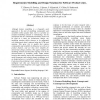980 search results - page 3 / 196 » Modeling Domain Variability in Requirements Engineering with... |
SPLC
2010
13 years 3 months ago
2010
Abstract. Feature modeling is a technique for capturing commonality and variability. Feature models symbolize a representation of the possible application configuration space, and ...
VAMOS
2007
Springer
13 years 12 months ago
2007
Springer
Goal models have been found to be effective for representing and analyzing variability at the early requirements level, by comprehensibly representing all alternative ways by whic...
UML
2005
Springer
13 years 11 months ago
2005
Springer
Understanding and maintenance of complex information spaces is often supported through visual interfaces. These interfaces must be highly flexible in order to adapt to both the u...
SE
2010
13 years 7 months ago
2010
: In this paper I explain the benefits of projectional language workbenches for product line engineering. The ability to extend programming languages with domain specific concepts,...
VAMOS
2007
Springer
13 years 12 months ago
2007
Springer
Although feature modelling is a frequently used approach to the task of modelling commonality and variability within product lines, there is currently no standard modelling notati...

